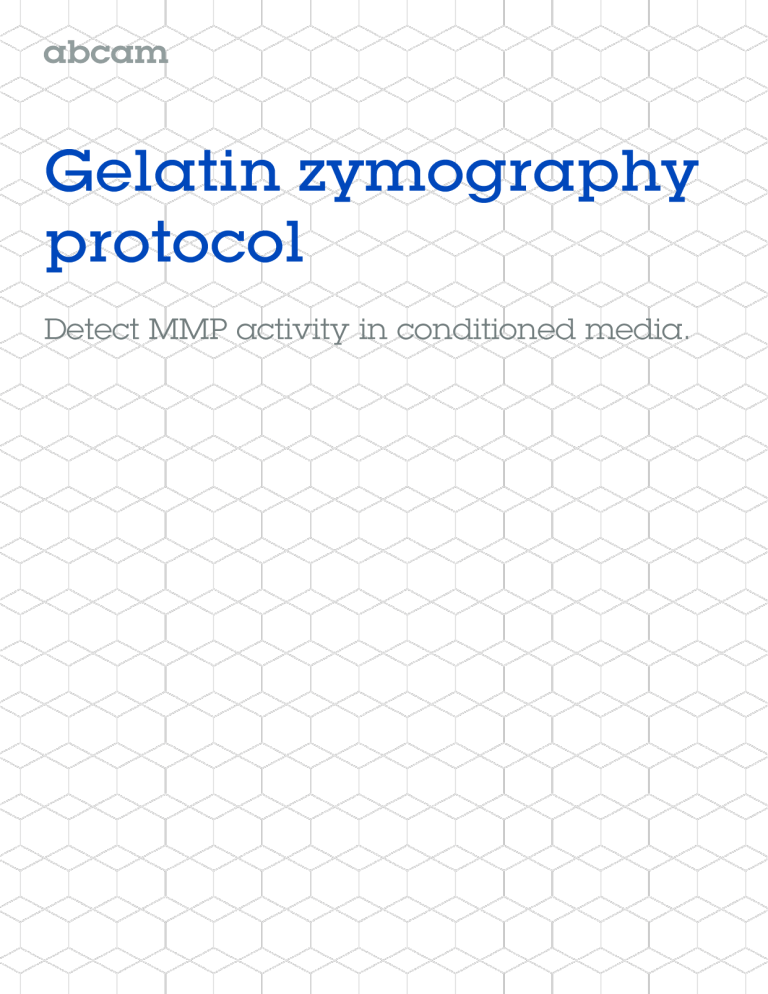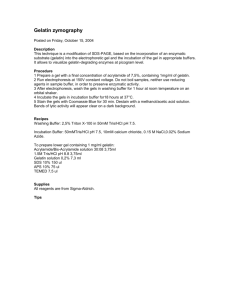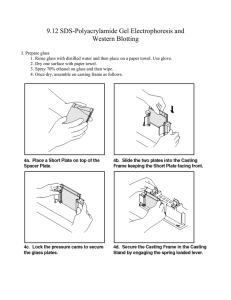
Gelatin zymography protocol Gelatin zymography is a method to detect activity of gelatinase enzymes, such as the matrix metalloproteinases (MMPs) MMP-2 and MMP-9. Active gelatinases digest gelatin embedded in a polyacrylamide gel. After Coomassie staining, areas of degradation are visible as clear bands against a darkly stained background. This protocol is optimized for detecting secreted MMP-9 and MMP-2 activity in conditioned media. 1. Plate cells cultured in fetal bovine serum (FBS) in a six-well plate (2 mL/well) or in a 75 cm2 flask (10 mL) 2. At 70–80% confluency, remove FBS media, wash cells twice with RBS-free media and continue to grow cells in FBS-free media. The duration of growth in FBS-free media must be optimized for the cell line: for example, 231G and 468 breast cancer cells require a 40–44 h growth period before collection of conditioned media. 3. Collect conditioned media and centrifuge or filter to eliminate dead cells 4. Concentrate conditioned media 10X Running the gel 1. Adjust conditioned media in all samples to the same protein concentration. For each sample, test one aliquot at a low protein concentration (5 µg/mL) and one at a high protein concentration (15 µg/mL). 2. Add 5x non-reducing sample buffer to your samples 3. Prepare a 7.5% acrylamide gel containing gelatin. Use a 1 mm thickness plate. 2 Separating gel (7.5 % acrylamide) Stacking gel 1.5 M Tris pH 8.8 2 mL 0.5 M Tris pH 6.8 1.25 mL 30% acrylamide 2 mL 30% acrylamide 0.670 mL H2O 2 mL H2O 3.075 mL Gelatin (4 mg/mL) 2 mL 10 % SDS 50 μL 10% SDS 80 μL 10 % APS 50 μL 10% APS 80 μL TEMED 10 μL TEMED 10 μL 4. Load sample to each well; typically, 10 μL protein per well is suitable. Include a protein molecular weight marker in one well. Run the gel at 150 V until good band separation is achieved. Gel washing and staining 1. Wash the gel 2 x 30 min with washing buffer. Soaking the gel in washing buffer removes SDS from the gel. 2. Rinse for 5–10 min in incubation buffer at 37°C with agitation. 3. Replace with fresh incubation buffer and incubate for 24 h at 37°C. The incubation buffer contains cofactors necessary for the gelatinase reaction to occur. 4. Stain the gel with staining solution for 30 min to 1 h. Rinse with H 2O. 5. Incubate with destaining solution until bands can clearly be seen. Areas of enzyme activity appear as white bands against a dark blue background. 5X non-reducing sample buffer 3 Final concentration For 250 mL 4% SDS 10 g 20% glycerol 50 mL of 100% 0.01% bromophenol blue 0.025 g 125 mM Tris-HCl, pH 6.8 4.91 g Washing buffer Final concentration For 250 mL 2.5% Triton X-100 6.25 mL of 100% 50 mM Tris-HCl, pH 7.5 12.5 mL of 1 M stock 5 mM CaCl2 625 µL of 2 M stock 1 µM ZnCl2 2.5 µL of 0.1 M stock Incubation buffer For 250 mL Triton x 100 1 % 2.5 mL of 100 % Tris HCl 50 mM pH 7.5 12.5 mL of 1 M 5mM CaCl2 625 μl of 2 M 1 µM ZnCl2 2.5 μl of 0.1 M Staining solution For 100 mL Methanol 40 mL Acetic acid 10 mL H 2O 50 mL Coomassie Blue 0.5 g Destaining solution For 1 L 4 Methanol 400 mL Acetic acid 100 mL H 2O 500 mL




